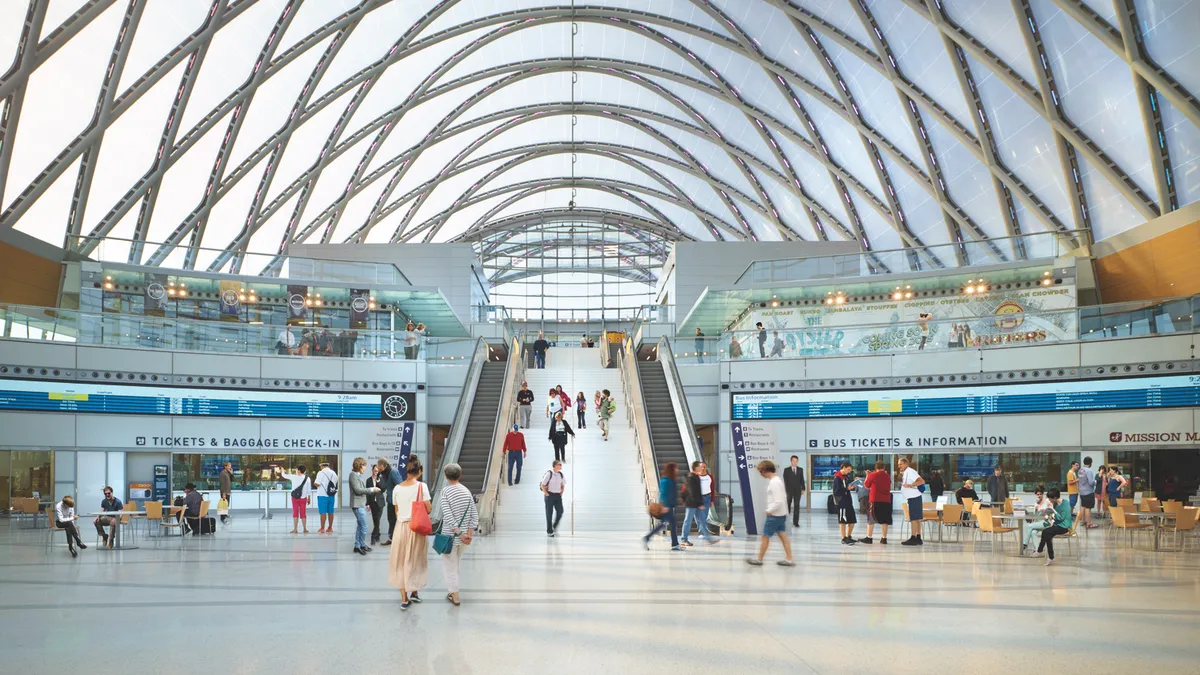Major hubs like Union Station in Washington, DC, Pennsylvania Station in New York City and 30th Street Station in Philadelphia are taking stock and ordering up hundreds of millions — if not billions — of dollars in facelifts not only to expand traveler capacity, but to look good doing it.
The drivers behind these transformations include a desire to entice people to come by and check out their dining, drinking, retail and event offerings — whether they’re traveling or not — as well as to give commuters a reason to stick around rather than just passing through.
There’s a spate of new transit hub construction happening in the U.S., and the resulting work in both the traditional rail and light rail station segments have something in common: their potential to spur development and convert the old-time train station into a destination itself.
Changing perceptions
People regularly travel through these transit hubs for work without stopping or thinking about how they impact the structures, but they are nevertheless assisting in their wear and tear, according to real estate attorney B.A. Spignardo of Shapiro Lifschitz & Schram in Washington, DC.
"Many of these buildings are incredibly old with amazing architecture to preserve, but [the stations] are dealing with the ebb and flow of travel," she said.
Redeveloping and changing the perception of these transit hubs, Spignardo noted, will draw in people to shop and socialize even when they’re not taking a trip, as well as give everyday passengers an excuse to stop and eat or have a drink with friends or colleagues instead of continuing to their next destination right away.
"It’s a way to [achieve] balance and attract people during off hours and use the structures that exist, which are an attraction in themselves," she said.
Amtrak announced in March 2016 that it plans to build a $50 million concourse in DC’s Union Station, just part of the development going on in and around the facility. In 1988, the station completed a $160 million overhaul and already offers its 90,000 daily travelers more than 40 dining options and 100 specialty stores. Included in the new development is a 3-million-square-foot mixed-use complex called Burnham Place that will provide residential, retail and commercial space, all situated above the station.
Last summer, Amtrak also proposed a whopping $6.5 billion overhaul to Philadelphia’s 30th Street station, a massive undertaking involving construction over rail yards, development of an underground concourse and the creation of a "dense urban neighborhood."
L. Bert Cossaboon, vice president at design firm McCormick Taylor, said the Southeastern Pennsylvania Transportation Authority has also invested heavily in the King of Prussia Rail project. Instead of building a mixed-use development around the major stations, the rail system delivers passengers to a vast shopping area, along with residential and commercial spaces. However, he added that transit hub development is a growing movement beyond just the Northeast.
"I think it's a huge trend nationally, not to just build transit for mobility, but to achieve other objectives like jobs, economic development and livability," Cossaboon said. "The more transit investment can spur hubs and centers of activity, the more ridership they get. It’s in their best interest to invest."
A modern take
These developments don’t always have to center around the renovation of historic buildings. Architecture firm HOK designed the Anaheim Regional Transportation Intermodal Center (ARTIC) in California, a 21st century take on the massive transit halls of the past. Finished in 2014, using steel and ethylene tetrafluoroethylene "pillows," designers created a hangar-like, light-filled area that makes room for dining and shopping, as well as for additional future commercial development.
Skanska also completed an ultra-modern, $4 billion World Trade Center Transportation Hub last year, which connects city subway lines and PATH trains to New Jersey, to replace the one destroyed in the Sept. 11 terrorist attacks. It features a dove-shaped centerpiece called the Oculus designed by Santiago Calatrava, as well as 75,000 square feet of retail space.
Michael Viggiano, an executive vice president at Skanska USA Civil, said that, rather than serve as an example of a typical transit hub, the project was more of a statement to the world that New York could overcome the past and look to the future.
Unlike the WTC and ARTIC however, Skanska’s upcoming $1.6 billion, 255,000-square-foot renovation — along with joint venture partners Vornado Realty Trust and Related Co. — of the James Farley Post Office into a transit hall for Pennsylvania Station next door will demonstrate the planning required to add modern features while still trying to preserve the look and historical feel of an existing structure. Achieving the desired balance presents significant challenges, Viggiano said, including those relating to sustainability.
"There's a lot of opportunities to increase efficiency, especially considering the way the old building used to operate," Viggiano said. "All the new electrical systems and all the new mechanical systems are a hundred times more efficient than even 20 to 40 years ago. Just going to LED lighting is a tremendous way to improve efficiency and make it more sustainable."
Upon completion in 2020, the new Moynihan Hall will boast 112,000 square feet of retail and 588,000 square feet of office space, in addition to new waiting and ticket areas.
This development as well as others that aim to appeal to a broader base than just travelers, Viggiano said, have the potential to spur activity and economic benefit for the surrounding area and city. "It creates a whole social network around itself," he said.






















